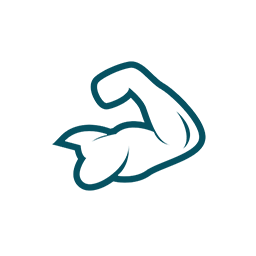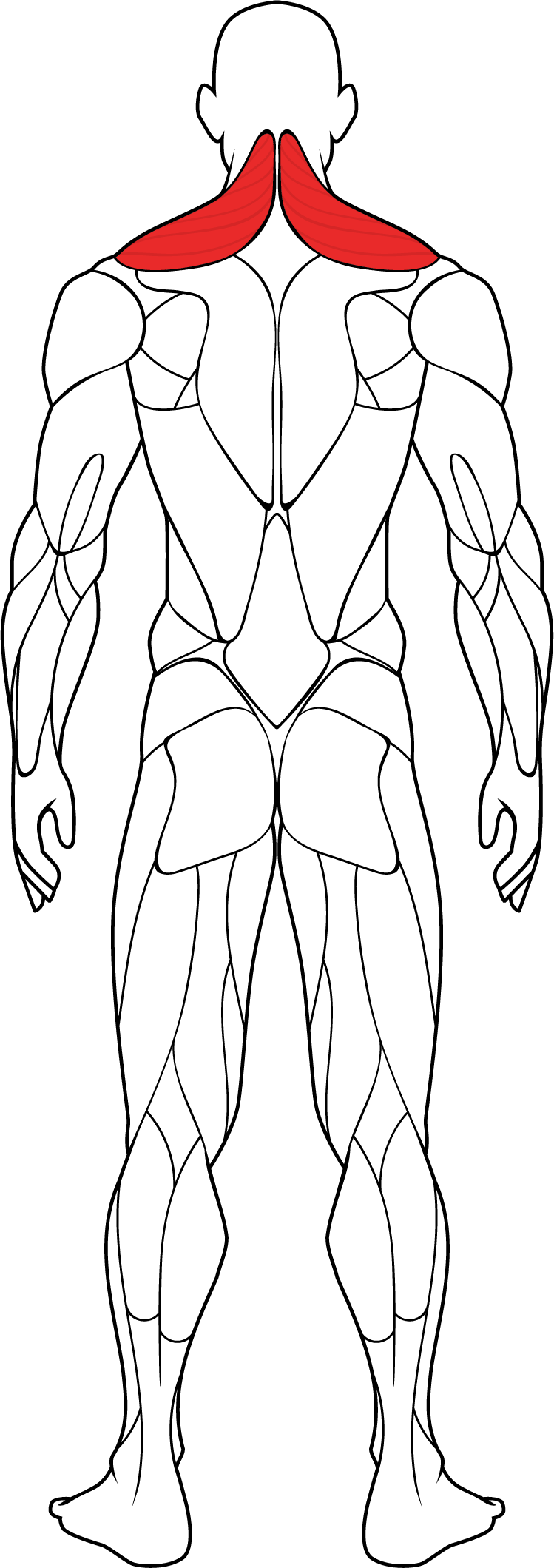The traps, short for trapezius muscles, are a large, triangular-shaped pair of muscles located on the upper back and neck. They are named after their trapezoid shape, which extends from the base of the skull, along the spine (down to the mid-back), and out toward the shoulder blades. The trapezius muscles are divided into three main regions: the upper traps, middle traps, and lower traps.
The traps, short for trapezius muscles, are a large, triangular-shaped pair of muscles located on the upper back and neck. They are named after their trapezoid shape, which extends from the base of the skull, along the spine (down to the mid-back), and out toward the shoulder blades. The trapezius muscles are divided into three main regions: the upper traps, middle traps, and lower traps.
Functions of the trapezius muscles include:
Scapular Elevation: The upper traps are primarily responsible for elevating the shoulder blades (scapulae) toward the ears, such as during shrugging movements. This action is essential for movements like lifting objects or performing overhead activities.
Scapular Retraction: The middle traps play a significant role in retracting the shoulder blades toward the spine. This action involves squeezing the shoulder blades together, as in pulling movements (e.g., rowing exercises), and helps maintain proper posture and shoulder alignment.
Scapular Depression: The lower traps assist in depressing the shoulder blades downward, away from the ears. This action is important for stabilizing the shoulders and maintaining proper posture, especially during activities such as hanging from a bar or performing exercises in which the arms are overhead.
Neck Support: The trapezius muscles also provide support to the neck and head, assisting in maintaining proper alignment and stability during movements such as tilting and rotating the head.
Head and Neck Movement: The upper portion of the trapezius muscles contributes to movements of the head and neck, such as turning the head side to side and tilting it backward.
Strengthening the trapezius muscles is important for improving upper body strength, posture, and overall function. Some common exercises that target the traps include:
Barbell Shrugs: Barbell shrugs are performed by holding a barbell in front of the thighs with an overhand grip and shrugging the shoulders upward toward the ears. This movement primarily targets the upper traps and is effective for building strength and size in this region.
Dumbbell Shrugs: Similar to barbell shrugs, dumbbell shrugs involve holding a dumbbell in each hand at the sides and shrugging the shoulders upward. Dumbbell shrugs allow for a greater range of motion and can help address muscular imbalances between the left and right sides of the body.
Cable Shrugs: Cable shrugs are performed using a cable machine with a handle attachment. Stand facing the machine, grasp the handle with both hands, and shrug the shoulders upward against the resistance provided by the cable. Cable shrugs provide constant tension throughout the movement and can help develop symmetrical trap development.
Face Pulls: Face pulls are performed using a cable machine with a rope attachment. Stand facing the machine, grasp the rope handles with an overhand grip, and pull the handles toward your face while squeezing the shoulder blades together. Face pulls target the middle and upper traps, as well as the rear deltoids and rotator cuff muscles.
Inverted Rows: Inverted rows, also known as bodyweight rows or Australian pull-ups, are performed using a horizontal bar or suspension trainer. Lie underneath the bar, grasp it with an overhand grip, and pull your chest toward the bar while keeping your body in a straight line. Inverted rows engage the middle and lower traps, as well as the muscles of the back and arms.
Incorporating a variety of these exercises into your workout routine can help develop strong, well-defined trapezius muscles, improve posture, and enhance overall upper body strength and function. As with any exercise program, it's essential to perform movements with proper form and technique to maximize effectiveness and minimize the risk of injury. If you're new to strength training or have any concerns, consider working with a qualified fitness professional to develop a safe and effective workout plan tailored to your goals and fitness level.
Functions of the trapezius muscles include:
Scapular Elevation: The upper traps are primarily responsible for elevating the shoulder blades (scapulae) toward the ears, such as during shrugging movements. This action is essential for movements like lifting objects or performing overhead activities.
Scapular Retraction: The middle traps play a significant role in retracting the shoulder blades toward the spine. This action involves squeezing the shoulder blades together, as in pulling movements (e.g., rowing exercises), and helps maintain proper posture and shoulder alignment.
Scapular Depression: The lower traps assist in depressing the shoulder blades downward, away from the ears. This action is important for stabilizing the shoulders and maintaining proper posture, especially during activities such as hanging from a bar or performing exercises in which the arms are overhead.
Neck Support: The trapezius muscles also provide support to the neck and head, assisting in maintaining proper alignment and stability during movements such as tilting and rotating the head.
Head and Neck Movement: The upper portion of the trapezius muscles contributes to movements of the head and neck, such as turning the head side to side and tilting it backward.
Strengthening the trapezius muscles is important for improving upper body strength, posture, and overall function. Some common exercises that target the traps include:
Barbell Shrugs: Barbell shrugs are performed by holding a barbell in front of the thighs with an overhand grip and shrugging the shoulders upward toward the ears. This movement primarily targets the upper traps and is effective for building strength and size in this region.
Dumbbell Shrugs: Similar to barbell shrugs, dumbbell shrugs involve holding a dumbbell in each hand at the sides and shrugging the shoulders upward. Dumbbell shrugs allow for a greater range of motion and can help address muscular imbalances between the left and right sides of the body.
Cable Shrugs: Cable shrugs are performed using a cable machine with a handle attachment. Stand facing the machine, grasp the handle with both hands, and shrug the shoulders upward against the resistance provided by the cable. Cable shrugs provide constant tension throughout the movement and can help develop symmetrical trap development.
Face Pulls: Face pulls are performed using a cable machine with a rope attachment. Stand facing the machine, grasp the rope handles with an overhand grip, and pull the handles toward your face while squeezing the shoulder blades together. Face pulls target the middle and upper traps, as well as the rear deltoids and rotator cuff muscles.
Inverted Rows: Inverted rows, also known as bodyweight rows or Australian pull-ups, are performed using a horizontal bar or suspension trainer. Lie underneath the bar, grasp it with an overhand grip, and pull your chest toward the bar while keeping your body in a straight line. Inverted rows engage the middle and lower traps, as well as the muscles of the back and arms.
Incorporating a variety of these exercises into your workout routine can help develop strong, well-defined trapezius muscles, improve posture, and enhance overall upper body strength and function. As with any exercise program, it's essential to perform movements with proper form and technique to maximize effectiveness and minimize the risk of injury. If you're new to strength training or have any concerns, consider working with a qualified fitness professional to develop a safe and effective workout plan tailored to your goals and fitness level.


